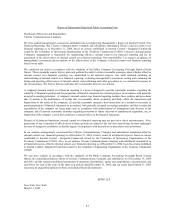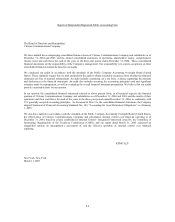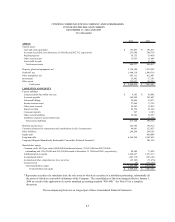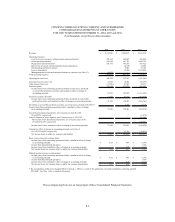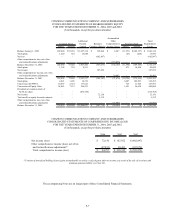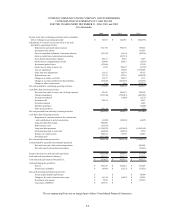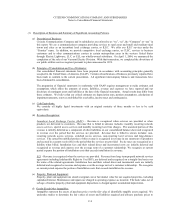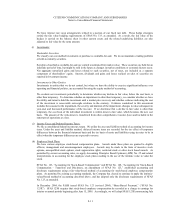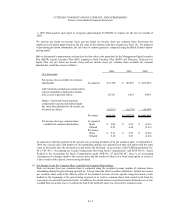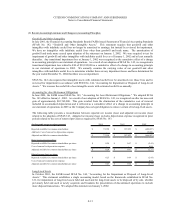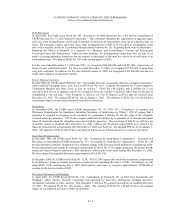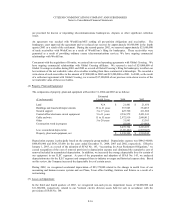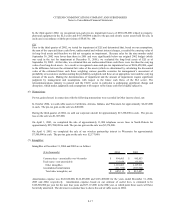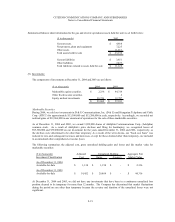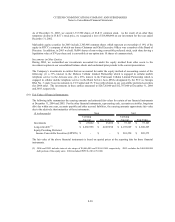Frontier Communications 2004 Annual Report Download - page 57
Download and view the complete annual report
Please find page 57 of the 2004 Frontier Communications annual report below. You can navigate through the pages in the report by either clicking on the pages listed below, or by using the keyword search tool below to find specific information within the annual report.
CITIZENS COMMUNICATIONS COMPANY AND SUBSIDIARIES
Notes to Consolidated Financial Statements
F-13
(2) Recent Accounting Literature and Changes in Accounting Principles:
Goodwill and Other Intangibles
In July 2001, the Financial Accounting Standards Board (FASB) issued Statement of Financial Accounting Standards
(SFAS) No. 142, “Goodwill and Other Intangible Assets.” This statement requires that goodwill and other
intangibles with indefinite useful lives no longer be amortized to earnings, but instead be reviewed for impairment.
We have no intangibles with indefinite useful lives other than goodwill and trade name. The amortization of
goodwill and trade name ceased upon adoption of the statement on January 1, 2002. We were required to test for
impairment of goodwill and other intangibles with indefinite useful lives as of January 1, 2002 and at least annually
thereafter. Any transitional impairment loss at January 1, 2002 was recognized as the cumulative effect of a change
in accounting principle in our statement of operations. As a result of our adoption of SFAS No. 142, we recognized a
transitional impairment loss related to ELI of $39,812,000 as a cumulative effect of a change in accounting principle
in our statement of operations in 2002. We annually examine the carrying value of our goodwill and other
intangibles with indefinite useful lives to determine whether there are any impairment losses and have determined for
the year ended December 31, 2004 that there was no impairment.
SFAS No. 142 also requires that intangible assets with estimated useful lives be amortized over those lives and be
reviewed for impairment in accordance with SFAS No. 144, “Accounting for Impairment or Disposal of Long-Lived
Assets
.”
We reassess the useful life of our intangible assets with estimated useful lives annually.
Accounting for Asset Retirement Obligations
In June 2001, the FASB issued SFAS No. 143, “Accounting for Asset Retirement Obligations.” We adopted SFAS
No. 143 effective January 1, 2003. As a result of our adoption of SFAS No. 143, we recognized an after tax non-cash
gain of approximately $65,769,000. This gain resulted from the elimination of the cumulative cost of removal
included in accumulated depreciation and is reflected as a cumulative effect of a change in accounting principle in
our statement of operations in 2003 as the Company has no legal obligation to remove certain of its long-lived assets.
The following table presents a reconciliation between reported net income (loss) and adjusted net income (loss)
related to the adoption of SFAS 143. Adjusted net income (loss) excludes depreciation expense recognized in prior
periods related to the cost of removal provision as required by SFAS No. 143.
Long-Lived Assets
In October 2001, the FASB issued SFAS No. 144, “Accounting for the Impairment or Disposal of Long-Lived
Assets.” This statement establishes a single accounting model, based on the framework established in SFAS No.
121, for impairment of long-lived assets held and used and for long-lived assets to be disposed of by sale, whether
previously held and used or newly acquired, and broadens the presentation of discontinued operations to include
more disposal transactions. We adopted this statement on January 1, 2002.
(In thousands, except per-share amounts) 2004 2003 2002
Reported available for common shareholders 72,150$ 187,852$ (682,897)$
Add back: Cost of removal in depreciation expense - - 15,990
Adjusted available for common shareholders 72,150$ 187,852$ (666,907)$
Basic income (loss) per share:
Reported available for common shareholders per share 0.24$ 0.67$ (2.43)$
Cost of removal in depreciation expense - - 0.06
Adjusted available for common shareholders per share 0.24$ 0.67$ (2.37)$
Diluted income (loss) per share:
Reported available for common shareholders per share 0.23$ 0.64$ (2.43)$
Cost of removal in depreciation expense - - 0.06
Adjusted available for common shareholders per share 0.23$ 0.64$ (2.37)$


